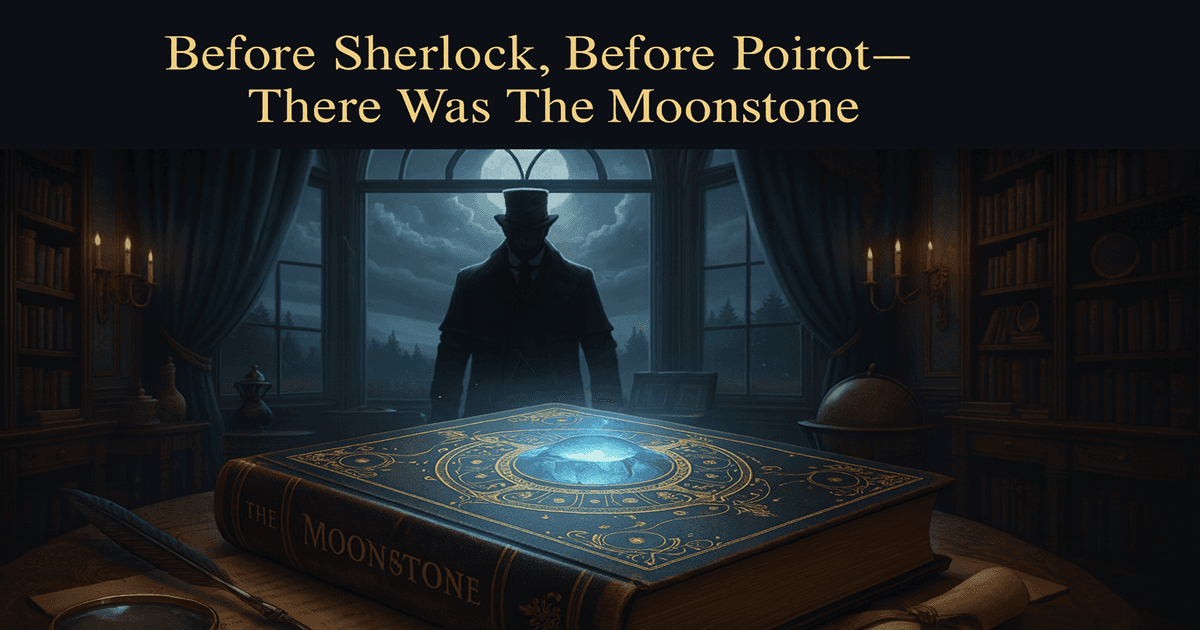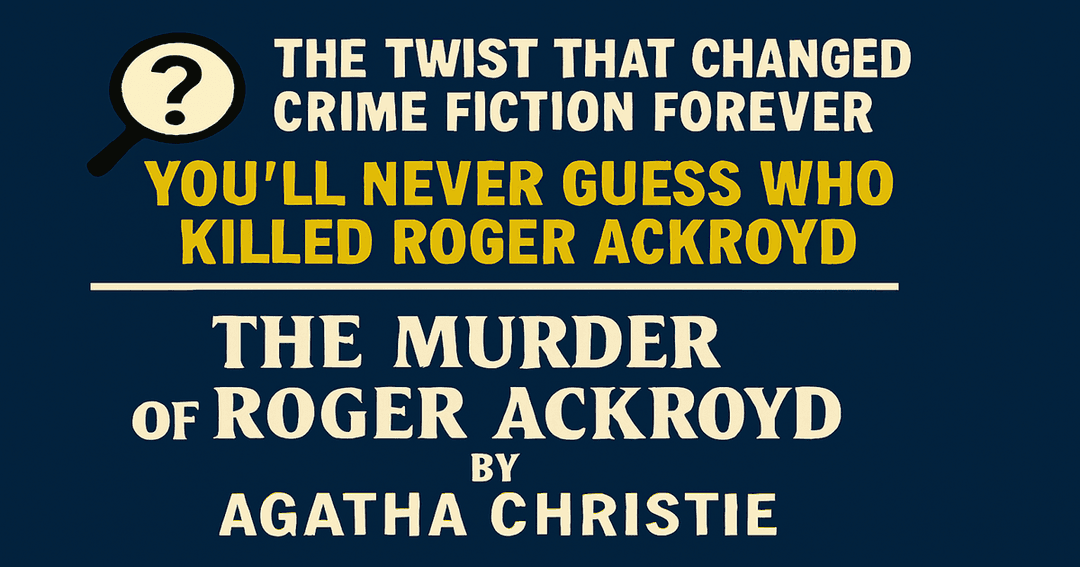How Wilkie Collins' The Moonstone became the secret blueprint for modern mystery fiction
When readers picked up The Moonstone in 1868, they had no idea they were witnessing the birth of an entire genre. Wilkie Collins didn't just write a mystery novel—he created the DNA that every detective story since has carried in its literary bloodstream.
What Is The Moonstone Novel About?
The Moonstone tells the story of a cursed yellow diamond stolen from Rachel Verinder's bedroom on her eighteenth birthday. The massive gem, originally plundered from an Indian temple, disappears during a house party at the Verinder family estate in Yorkshire.
The novel unfolds through multiple narrators, each telling their part of the mystery. From Gabriel Betteredge, the loyal house steward, to the famous detective Sergeant Cuff, each character reveals crucial pieces of the puzzle while hiding their own secrets.
The Plot That Changed Everything
The story begins when Colonel Herncastle bequeaths the Moonstone to his niece Rachel as a twisted birthday gift. Three mysterious Indians have been tracking the diamond across England, determined to return it to their temple. When the stone vanishes from Rachel's room, suspicion falls on everyone present—including Franklin Blake, Rachel's cousin and romantic interest.
Detective Sergeant Cuff arrives to investigate, but his conclusions prove devastatingly wrong. The real solution emerges through the collective testimonies of various witnesses, each contributing vital information without realizing its significance.
Why The Moonstone Is Called the First Detective Novel
Literary scholars consistently rank The Moonstone as the first full-length detective novel in English literature. Published twenty years before Arthur Conan Doyle introduced Sherlock Holmes, Collins established the fundamental elements that define detective fiction:
A central mystery requiring investigation
A professional detective character (Sergeant Cuff)
Multiple suspects with motives and opportunities
Red herrings to mislead readers
Logical deduction leading to solution
Fair play with all clues presented to readers
T.S. Eliot called it "the first, the longest, and the best of modern English detective novels," cementing its literary importance.
Collins' Revolutionary Techniques
Collins pioneered several narrative techniques that modern mystery writers still employ:
Multiple perspectives: Each narrator tells their portion of events, creating a kaleidoscopic view of the truth. This technique predates famous unreliable narrators in contemporary fiction by over a century.
Psychological realism: Characters behave according to complex psychological motivations rather than simple plot requirements. Rachel's silence about the theft stems from genuine emotional conflict, not convenient plotting.
Social commentary: The novel critiques British colonialism through the diamond's backstory, questioning the morality of imperial wealth while entertaining readers with mystery elements.
Character Analysis: The People Behind the Mystery
Sergeant Cuff: The Detective Who Gets It Wrong
Sergeant Cuff represents Collins' subversive approach to detective fiction. Unlike the infallible detectives who would follow him, Cuff makes fundamental errors in reasoning. His obsession with roses and working-class background make him relatable, but his conclusions about Rachel and the servants prove spectacularly incorrect.
This fallibility was revolutionary. Collins showed that even trained investigators could be wrong, making the truth more complex and interesting than simple deduction could reveal.
Rachel Verinder: The Complicated Heroine
Rachel knows the thief's identity from the beginning but remains silent throughout most of the novel. Modern readers sometimes find her frustrating, but Collins crafted her silence as social commentary on Victorian women's limited agency.
Her refusal to speak stems from love, shame, and social constraints that make the truth more dangerous than mystery. Rachel represents Collins' understanding that victims aren't always innocent and heroes aren't always heroic.
Franklin Blake: The Unreliable Narrator
Franklin serves as both narrator and unwitting criminal, stealing the diamond while under the influence of laudanum (medicinal opium). His drug-induced sleepwalking provides the novel's central twist while addressing Victorian anxieties about addiction and medical treatments.
Blake's character explores themes of unconscious guilt and the relationship between addiction and crime, topics that remain relevant in contemporary discussions of mental health and substance abuse.
The Moonstone's Literary Impact and Influence
How The Moonstone Influenced Famous Authors
Arthur Conan Doyle acknowledged Collins' influence on the Sherlock Holmes stories, particularly the methodical investigation techniques and the country house setting.
Agatha Christie borrowed Collins' multiple narrator structure for novels like The Murder of Roger Ackroyd, which features an unreliable narrator similar to Blake.
Dorothy Sayers praised Collins' fair play approach, where all clues are available to readers, making the mystery solvable through careful attention to details.
Modern Detective Fiction's Debt to Collins
Contemporary mystery writers continue using Collins' innovations:
Unreliable narrators (Gone Girl, The Girl on the Train)
Multiple perspectives (In the Woods, The Thursday Murder Club)
Flawed detectives (True Detective, Broadchurch)
Social commentary within mystery (Tana French novels, Kate Atkinson's Jackson Brodie series)
Themes and Symbolism in The Moonstone
Colonialism and Cultural Appropriation
The Moonstone itself represents stolen wealth and colonial violence. Originally sacred to an Indian temple, the diamond brings misfortune to everyone who possesses it illegally. Collins questioned British imperial morality decades before such criticism became mainstream.
The three Indians pursuing the diamond aren't villains but rightful owners seeking to restore their sacred object. This perspective was radical for Victorian readers accustomed to viewing colonial subjects as threats rather than victims.
Addiction and Victorian Medicine
Franklin's laudanum addiction reflects Victorian anxieties about medical treatments and their unintended consequences. Collins himself struggled with opium addiction, lending authenticity to Blake's experience with the drug's effects.
The novel explores how addiction can make people act against their moral principles, a theme that resonates with contemporary understanding of substance abuse disorders.
Class and Social Hierarchy
Collins presents characters from various social classes, from aristocratic Rachel to working-class servants, showing how the mystery affects people differently based on their social position. Sergeant Cuff's background as a former gardener emphasizes merit over birth, challenging Victorian class assumptions.
Why Read The Moonstone Today?
Relevance to Modern Readers
Despite its Victorian setting, The Moonstone addresses contemporary concerns:
Cultural repatriation of artifacts to origin countries
Addiction and mental health treatment approaches
Women's agency in patriarchal societies
Colonial legacies affecting modern politics
Truth and perspective in storytelling
Literary Merit and Entertainment Value
The Moonstone succeeds both as literature and entertainment. Collins balanced serious themes with engaging plot developments, creating a novel that satisfies both casual readers and literary scholars.
The book's serialized publication history means each chapter ends with compelling hooks, making it surprisingly page-turning for modern audiences accustomed to binge-watching television series.
Reading Guide: Understanding The Moonstone
Key Quotes and Their Significance
"The question of how I am to make myself intelligible to a person of such average capacity that he can understand what I say, is a question which I have never yet succeeded in settling to my own satisfaction." - Miss Clack's narrative voice reveals her self-righteousness while demonstrating Collins' skill at creating distinct character voices.
"I have never met with such a thing as a trifle yet." - Sergeant Cuff's attention to detail reflects the detective's methodology while foreshadowing his eventual errors in judgment.
Discussion Questions for Book Clubs
How does Collins use multiple narrators to reveal character psychology?
What role does the colonial backstory play in the mystery's resolution?
Why does Rachel remain silent about the theft for so long?
How do class differences affect characters' responses to the investigation?
What makes Sergeant Cuff both effective and ineffective as a detective?
The Moonstone's Place in Literature History
The Moonstone stands as a pivotal work in English literature, bridging Victorian social novels and modern detective fiction. Its influence extends beyond mystery writing to contemporary discussions of narrative reliability, cultural appropriation, and imperial history.
Collins created a template that writers continue to follow and subvert, proving the novel's enduring relevance to both literary scholars and general readers. Understanding The Moonstone provides insight into the origins of popular fiction genres and their evolution over time.
For readers interested in detective fiction's foundations, Victorian literature, or simply an engaging mystery story, The Moonstone offers rewards that justify its reputation as a groundbreaking masterpiece. The novel demonstrates how entertainment and serious artistic achievement can coexist, creating literature that both satisfies and challenges its audience.


